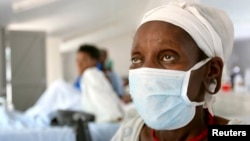Studies show a short course of an inexpensive anti-tuberculosis drug can dramatically reduce transmission of the bacterial respiratory disease. That's why many public health experts promote the use of the single antibiotic - called isoniazid - in communities with large populations of HIV-infected individuals -- people with notoriously high rates of secondary TB infections. Researchers, however, caution that widespread use of isoniazid could speed the emergence of drug-resistant strains of TB.
The World Health Organization recommends giving a six-month course of isoniazid preventive therapy (IPT) to three groups of people at risk of becoming infected with tuberculosis and spreading it to others. Included were individuals infected with HIV, the virus that causes AIDS; children under the age of five with immature immune systems; and people who have been exposed to tuberculosis and test positive for the disease.
In studies using short course anti-TB therapy, results have been impressive, according to Mario Raviglione, director of the World Health Organization’s Stop-TB office.
Raviglione says IPT suppresses TB infection in 60 to 70 percent of HIV-negative individuals and 80 to 90 percent of those with HIV.
“You just don’t become infectious to others and [you] yourself are not affected by the disease,” he said.
Despite the demonstrated effectiveness of isoniazid preventative therapy, Raviglione says it’s rarely used. He notes that IPT is limited to about 400,000 HIV-infected individuals, a fraction of the eight million people living with HIV globally who are at highest risk of becoming infected with TB. And he says the single-drug therapy is almost never used in children or others exposed to TB.
But with an estimated one-third of the world’s population infected with a latent form of TB that could become active -- and lethal -- at any time, some international public health officials have proposed using isoniazid prophylaxis, or prevention, in entire at-risk communities throughout the developing world.
Others, like Caroline Colijn, think such widespread use of isoniazid mono-therapy to contain TB is potentially too risky.
Colijn, of Imperial College London, and colleagues constructed a mathematical model that shows how blanketing a community with a single anti-TB drug, such as isoniazid in IPT, paves the way for the eventual emergence of drug-resistant strains of the TB bacterium.
“We don’t argue against doing IPT. It’s probably one of the best interventions we have against TB," he noted. "But we would definitely argue that we need to consider these long-term consequences and roll out appropriate treatment for resistant TB and treatment for TB.”
The WHO’s Raviglione agrees, saying the key to a successful tuberculosis prevention strategy is making sure people who are actively infected with TB are not treated with a single drug.
“This mathematical model doesn’t change our concern because we knew if you are not doing a proper job in screening out, in ruling out, active tuberculosis when you start prophylaxis, then you run the concrete risk of developing drug resistance in that very person,” he explained.
An article describing the risks of promoting drug-resistant forms of tuberculosis with the widespread use of Isoniazid Preventive Therapy against TB appears in the journal Science Translational Medicine.
The World Health Organization recommends giving a six-month course of isoniazid preventive therapy (IPT) to three groups of people at risk of becoming infected with tuberculosis and spreading it to others. Included were individuals infected with HIV, the virus that causes AIDS; children under the age of five with immature immune systems; and people who have been exposed to tuberculosis and test positive for the disease.
In studies using short course anti-TB therapy, results have been impressive, according to Mario Raviglione, director of the World Health Organization’s Stop-TB office.
Raviglione says IPT suppresses TB infection in 60 to 70 percent of HIV-negative individuals and 80 to 90 percent of those with HIV.
“You just don’t become infectious to others and [you] yourself are not affected by the disease,” he said.
Despite the demonstrated effectiveness of isoniazid preventative therapy, Raviglione says it’s rarely used. He notes that IPT is limited to about 400,000 HIV-infected individuals, a fraction of the eight million people living with HIV globally who are at highest risk of becoming infected with TB. And he says the single-drug therapy is almost never used in children or others exposed to TB.
But with an estimated one-third of the world’s population infected with a latent form of TB that could become active -- and lethal -- at any time, some international public health officials have proposed using isoniazid prophylaxis, or prevention, in entire at-risk communities throughout the developing world.
Others, like Caroline Colijn, think such widespread use of isoniazid mono-therapy to contain TB is potentially too risky.
Colijn, of Imperial College London, and colleagues constructed a mathematical model that shows how blanketing a community with a single anti-TB drug, such as isoniazid in IPT, paves the way for the eventual emergence of drug-resistant strains of the TB bacterium.
“We don’t argue against doing IPT. It’s probably one of the best interventions we have against TB," he noted. "But we would definitely argue that we need to consider these long-term consequences and roll out appropriate treatment for resistant TB and treatment for TB.”
The WHO’s Raviglione agrees, saying the key to a successful tuberculosis prevention strategy is making sure people who are actively infected with TB are not treated with a single drug.
“This mathematical model doesn’t change our concern because we knew if you are not doing a proper job in screening out, in ruling out, active tuberculosis when you start prophylaxis, then you run the concrete risk of developing drug resistance in that very person,” he explained.
An article describing the risks of promoting drug-resistant forms of tuberculosis with the widespread use of Isoniazid Preventive Therapy against TB appears in the journal Science Translational Medicine.










